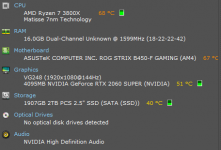jaydenrw98
Bronze Level Poster
Does anybody know what temperature motherboards should run at, mine has been jumping around idling anywhere between 40-60 and when gaming goes up to 70.
| Case | FRACTAL FOCUS G BLACK GAMING CASE (Window) |
| Processor (CPU) | AMD Ryzen 7 3800X Eight Core CPU (3.9GHz-4.5GHz/36MB CACHE/AM4) |
| Motherboard | ASUS® ROG STRIX B450-F GAMING (DDR4, USB 3.1, 6Gb/s) - RGB Ready! |
| Memory (RAM) | 16GB Corsair VENGEANCE DDR4 3600MHz (2 x 8GB) |
| Graphics Card | 8GB NVIDIA GEFORCE RTX 2060 SUPER - HDMI, DP - VR Ready! |
| 1st Storage Drive | 2TB PCS 2.5" SSD, SATA 6 Gb (520MB/R, 470MB/W) |
| DVD/BLU-RAY Drive | NOT REQUIRED |
| Power Supply | CORSAIR 550W TXm SERIES™ SEMI-MODULAR 80 PLUS® GOLD, ULTRA QUIET |
| Power Cable | 1 x 1 Metre UK Power Cable (Kettle Lead) |
| Processor Cooling | Corsair H80i V2 Hydro Series High Performance CPU Cooler |
| Thermal Paste | STANDARD THERMAL PASTE FOR SUFFICIENT COOLING |
| Extra Case Fans | 2x 120mm Black Case Fan (configured to extract from rear/roof)
|
| Sound Card | ONBOARD 6 CHANNEL (5.1) HIGH DEF AUDIO (AS STANDARD) |
| Wireless Network Card | WIRELESS INTEL® Wi-Fi 6 AX200 2,400Mbps/5GHz, 300Mbps/2.4GHz PCI-E CARD + BT 5.0 |
| USB/Thunderbolt Options | MIN. 2 x USB 3.0 & 2 x USB 2.0 PORTS @ BACK PANEL + MIN. 2 FRONT PORTS |
| Operating System | Windows 10 Home 64 Bit - inc. Single Licence [KUK-00001] |
| Operating System Language | United Kingdom - English Language |
| Windows Recovery Media | NO RECOVERY MEDIA REQUIRED |
| Office Software | FREE 30 Day Trial of Microsoft 365® (Operating System Required) |
| Anti-Virus | BullGuard™ Internet Security - Free 90 Day License inc. Gamer Mode |
| Browser | Google Chrome™ |
| Monitor | ASUS VG248QE 24" 3D 144Hz GAMING DISPLAY |
| Monitor Cables | 2 x 2 METRE DVI-D CABLE |

